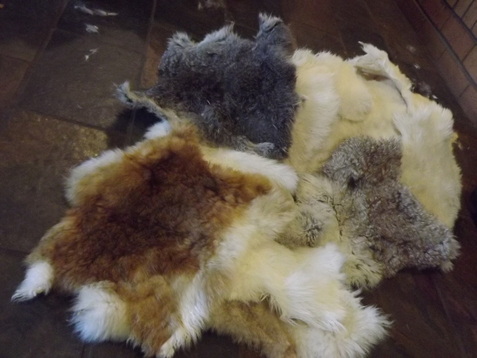Wash the skins to get any blood off them and remove any fat or meaty stuff sticking to the skins.
Add I cup of Salt and 1 cup of alum to 5 litres of water mix well and add the skins, we used a tub so the skins had plenty of room. Soak the skins in this for 2 days stirring twice a day to make sure every surface is getting plenty of contact with the solution.
Next the skins need to be fleshed - this is the removal of the fatty tissue and flesh to expose the actual leather so it is exposed to the chemical action. Rabbits have a clearly defined under tissue which, after the first soaking can be peeled of in one piece if you are careful, once this is done put them back into the solution and keep up the stirring twice a day routine for another seven days.
Next remove all of them from the solution and squeeze out the excess liquid. Then wash each pelt in a mild detergent, then rinse well and squeeze out excess liquid again.
Now, we are up to working the leather- the hides need to be stretched and worked to soften the leather as it dries. This works best while it is slightly damp, you can feel and see how well the softening is going as the skins are worked. Because the rabbit skin is thin, I think this process is easier than if you were tanning a sheep or cow skin. Also dry in the shade so they don't dry too quickly.
When it is dry give the fur a good brushing and put a little leather dressing on the skin side. Not sure what product is best for this. Easy.
Most of our method came from Martin's Aunty Margaret Abbott's instructions and Mother Earth News website.

 RSS Feed
RSS Feed